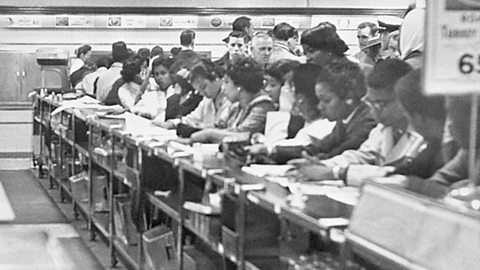Campaigns of the civil rights movement in the 1960s
The fight for civil rights intensified in the 1960s as people took inspiration from Rosa Parks and Martin Luther Kingâs successes in the 1950s. King spread his methods of non-violent protest through the Southern Christian Leadership ConferenceSCLCSouthern Christian Leadership Conference. A civil rights organisation set up in 1957 based on Christian values that peacefully campaigned against segregation in the USA. and local civil rights groups across the South. Non-violent protests took many forms but continued to increase the profile of the Civil rights movementAn organised set of activities that brought about a change in the treatment of people from different races in American society. throughout the 1960s.
Greensboro and the sit-in movement
segregationThis meant that white people and black people had to live separately. The areas of society affected by segregation included churches, hospitals, theatres and schools. in the South even extended to where people ate. Many of the lunch counters in the South were segregated. For example, in a Woolworth department store in Greensboro, North Carolina, there was a stand-up lunch counter for black people and a sit-down lunch counter for white people.
On 1 February 1960, four black students decided to challenge the segregated service. They bought items from the department store and sat at the white lunch counter. They were refused service and the manager tried, unsuccessfully, to have them arrested. They remained in their seats until the store closed.
News of the sit-in spread around the local university, so 31 students joined them the next day. After a few days, the lunch counter was filled with black students. After the news spread onto the television and into the newspapers, a number of sit-ins followed around the South.
Students in Nashville, Tennessee, held their own sit-ins. By 1960 Nashvilleâs eating areas were desegregationRemoval of laws that separate people from different races in public places and day-to-day life. King praised the organisation and discipline of Nashvilleâs civil rights activists.

The formation of the Student Nonviolent Coordinating Committee (SNCC)
The SCLC gave support to the student non-violent protest movement by creating a conference where regional leaders could meet and coordinate their efforts. During the conference the Student Nonviolent Coordinating CommitteeSNCCStudent Nonviolent Coordinating Committee initially promoted non-violent protest. was formed. This helped to bring black university students across the South together. King was persuaded to fund a conference by Ella Baker, who held the position of executive secretary of the SCLC.
Baker gave a speech to the students, encouraging their efforts and emphasising that their struggle was âmuch bigger than a hamburgerâ. Bakerâs enthusiasm and words helped to give the students the belief that their organisation could make a difference, allowing the movement to spread across the South.
Baker was described by SNCC members at the time as the âgodmotherâ of their organisation. The SNCCâs work organising sit-ins put pressure on local governments. After the success of these events, the SNCC supported non-violent protests across the country.
More guides on this topic
- Anti-Communism c.1945-1954 - OCR A
- African Americans c.1945-1954 - OCR A
- Broadening of the campaigns for civil rights - Race - OCR A
- Broadening of the campaigns for civil rights - Women's rights - OCR A
- Broadening of the campaigns for civil rights - Gay rights - OCR A
- Politics and protest - OCR A
- Social problems and attempts to tackle them - OCR A